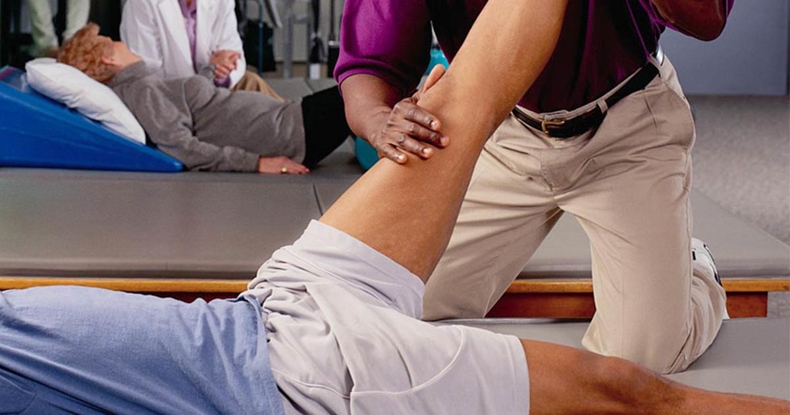How to Take Care of Your Bones Over a Lifetime
- Category: Health & Wellness, Bone and Joint Health
- Posted On:
- Written By: LVMC

Maintaining bone health is an important component of healthy living because bones affect many body processes and they are built to last a lifetime.
October marks the celebration of two important health holidays: Bone and Joint Health National Action Week (October 12 to 20), and World Pediatric Bone and Joint Day (October 19). Bone health is a vital part of healthy living. Nearly everyone can improve their quality of life, and prepare for a healthy future, by focusing on taking care of their bones.
At Lompoc Valley Medical Center, our medical providers work with patients every day to help them reach their healthy living goals. Read on to learn what you need to know about bone health, and how to take care of your bones throughout your lifetime.
The Basics of Bones
It is no wonder that often the only remaining evidence of a life form is its fossilized bones. Your bones are made of very durable materials that can withstand a lifetime of use. You are probably familiar with some of the more common minerals that make up your bones, such as calcium and phosphate. These minerals come partially from your diet, but also from other processes that occur in your body outside of your bones, such as your kidneys.
You can think of your bones as a storage center for minerals. Many of your bones are also very important sites for the production of blood cells, which grow inside the marrow (inner part) of bones. When all of your body’s organs are working well together, your bones are continuously being built up, broken down, and then replenished again. Experts at the US National Library of Medicine estimate that your entire skeleton gets replaced every ten years.
How Bones Change Throughout Your Life
At birth, your bones are not fully developed. The bones of your skull have not fused yet—which allows your brain to keep growing bigger and bigger without restriction. Growth plates in other bones and joints also allow for continuous growth until you reach your late teenage years or early twenties.
As your bones develop, they grow stronger and thicker, increasing in their density. When bones are growing the fastest, they can pick up more density, which is known as “bone mass.” According to the American Academy of Orthopedic Surgeons, most people reach their peak bone mass between the ages of 25 and 30. After that time, particularly after age 40, your bones start to gradually become thinner. While this is a normal part of aging, you can make a big difference in slowing bone loss through diet and exercise.
If your bones become thin enough, you might be diagnosed with a condition known as osteoporosis, which can make you especially vulnerable to breaking a bone.
How to Measure Bone Health
To measure your bone health, your medical provider may consider many factors. The first consideration will be your genes, as the bone density of your family members can have a big impact on your bone density. If you have ever had uncommon broken bones or fractures—or if you have had many broken bones without an explanation—your medical provider might suspect that you have low bone density. Low bone density may be obvious on a simple x-ray image, but to truly measure your bone density and track it over time, a medical provider may order bone densitometry, or DEXA, bone scan. A DEXA scan is a painless way for a medical provider to assess your bone health.
How to Protect Your Bones Over a Lifetime
Your bone health is largely in your control, even if you have a family history of low bone density conditions like osteoporosis. Keeping your bones at the forefront of your mind can go a long way in keeping you healthy throughout your lifetime. Here are some of the most important things you can do for optimal bone and joint health.
Monitor Your Dietary Calcium and Vitamin D Intake
When you are young, it may be easy to disregard dietary recommendations—such as those for calcium and Vitamin D—because you may be feeling well and have no symptoms of mineral deficiencies. However, building strong bones during your childhood and adolescence sets a very important foundation for your future bone health.
Medical providers recommend that you pay attention to the amount of calcium that you eat in your diet because calcium is an essential ingredient for your bones. Getting enough calcium can make sure that your bones stay healthy, and that all of your body’s cells and organs also have the calcium that they need to function. Rich dietary sources of calcium include cheese, yogurt, cow’s milk, almond milk, tofu, fortified grains, collard greens, kale, and bok choy.
Medical providers recommend that you monitor your Vitamin D intake, as well, because Vitamin D helps your body absorb calcium. Vitamin D is not as easy to come by in the standard American diet, because it is only present in high amounts in a few food sources, such as fatty fish flesh and fish liver oils. There is a small amount of Vitamin D in beef liver, egg yolks, cheese, and mushrooms, too. Because it is difficult for most people to get enough Vitamin D through their diet, medical providers recommend Vitamin D supplements, starting in infancy and extending to age 70.
A basic breakdown of the daily recommended calcium and Vitamin D intake, by age group, is as follows:
- 1st year of life: 200mg to 260mg of calcium (through formula or breast milk), with 400IU of Vitamin D supplement
- Age 1 to 3: 700mg daily calcium, and 600IU of Vitamin D
- Age 4 to 8: 1000mg daily calcium and 600 to 1000IU of Vitamin D
- Puberty and Adolescence: 1300mg daily calcium, 600 to 1000IU of Vitamin D
- Age 20 to 30: 1000mg daily calcium, 600 to 1000IU of Vitamin D
- Age 30 to 50: 1000mg daily calcium, 600 to 1000IU of Vitamin D
- Age 50 to 70: 1200mg daily calcium (especially for post-menopausal women), 600 to 1000IU of Vitamin D
- Age 70 and up: 1200mg daily calcium, 800IU Vitamin D
For reference, an 8-ounce glass of milk will generally have about 300mg of calcium, as will a serving of tofu or kale.
Protect Yourself From Injury
Breaking a bone can slow you down in a tremendous way, and it can often lead to other medical problems. Avoiding injury to your bones is important at every stage of life.
Here are a few important ways to protect your bones from injury:
- Wear a helmet when riding bikes, scooters, skateboards, motorcycles, or other small vehicles
- Wear proper protective equipment when playing team sports
- Make sure that you reduce your fall risk around your house (is there a rug that you could accidentally trip over during a midnight trip to the bathroom?)”
- Wear supportive footwear
Protecting your bones from injury is about more than just external protection, however. Internally, you can safeguard your bones by eating a healthy diet and exercising.
Do Regular Weight-Bearing Exercise
When you exercise, particularly when you do weight-bearing exercise, you can significantly add to the density of your bones. The National Osteoporosis Foundation (NOF) notes that high-impact weight-bearing exercises, such as dancing, hiking, or tennis, are particularly beneficial. However, low-impact weight-bearing exercises, such as elliptical trainers or fast walking, can also help you keep up your bone density and protect your bones from breaking. The NOF notes that muscle strengthening, or resistance, exercises, such as weight-lifting, can also benefit your bones.
Avoid Behaviors That Decrease Bone Density
Knowing what can help you avoid bone thinning can also be an important step in taking care of your bones. Some of the most common activities that can lead to decreased bone density, and an increased risk of a broken bone, include:
- Cigarette smoking
- Eating a poor diet low in calcium
- Drinking alcohol excessively
- Binge-eating or starvation
You can maximize your bone health by avoiding these behaviors altogether or seeking resources to help you make positive changes.
Managing Bone Density
It is possible that, despite your best efforts, you may develop thin bones or maybe even osteoporosis. One of the biggest factors that weaken bones is simply aging. Many common medical conditions can also contribute to bone loss, such as diabetes, rheumatoid arthritis, and chronic kidney disease. Certain surgeries—such as organ transplants, or gastric bypass procedures—may also affect bone health. Regardless of what factors lead to low bone density, it’s important to know that there are many medications available to help you prevent further bone loss and avoid future fractures. Some new medications may even help you reverse the bone loss that has occurred.
Weighing Prescription Benefits
While there are many medications available to help increase your bone density, there may be just as many that can reduce your bone density. Common medications that may affect bone density include corticosteroids, hormone medications, and some seizure medications. If you are concerned about your bone density and taking a medication that you think may be affecting your bones, make sure to talk to your medical provider.
Taking Care Of Your Bones with Lompoc Valley Medical Center
At Lompoc Valley Medical Center, our medical providers are experts at helping you adopt healthy living habits that can keep you feeling well throughout your lifetime, and this includes an emphasis on bone health. To learn more, visit us today.




